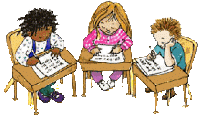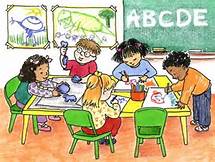
Salty Sam’s Fun Blog for Children
Number 247
Learning the Times Tables
Hello Everyone

Well, after all that frantic activity last week, the smell of paint is beginning to fade in the Rocky Bay Chip Shop.
Henry has hung a notice on the door of the attic.
lt reads ‘The Awesome Foursome’s HQ’.
lt will be a lovely, cosy place to be when the chilly winter weather comes.
The children have been up there quite a lot playing, and even if they make quite a lot of noise there isn’t anyone close by to hear them.
But of course the rest of life has gone on.
The leaves are falling in the gardens and the woods and the evenings are getting darker. This is good for anyone who, like Henry, has a telescope.
But then Henry’s mother had a look in some of Henry’s exercise books from school and was a bit surprised at some of his low marks. She wondered if Henry had been neglecting his homework in all the excitement of his new playroom.
Henry told her that he was having trouble learning his times tables. He said that the numbers just whirled round in his head and he just couldn’t remember them.
Henry’s mother said that maybe he could practise them with his friends when they came round instead of playing with his toys all the time.
Henry went to tea at Auntie Alice’s house one evening this week with Bill and Bob and told Auntie Alice about his problem. Auntie Alice is the sort of kindly person people like telling their problems to.
Auntie Alice said that the way you remember things is to repeat doing them – and if you can turn this process into a kind of game, it makes it so much more fun.
She said that there were different ways to learn times tables.
You could write them out many times.
You could learn them by chanting them.
You could draw a chart of 144 squares in blocks of ten for each table and colour in the right answer. You can use a different colour for each number – red for two, orange for three, yellow for four, green for five and so on – following the colours of the rainbow.
Different people liked to learn things in different ways.
Then she had an idea. She cut out lots of cards and wrote a question on one side and an answer on the other.
Then explained how her game worked.
Each child had to pick up a card and give an answer to the sum. Then they had to check they were right by turning the card over.
At the same time they could play a game of noughts and crosses. lf they got an answer right they were allowed to write down a nought or cross – depending on which they were playing.
Of course this game would work with other games as well like boxes (Blog Post 38) or snakes and ladders – you would not be able to throw the die until you had correctly answered a question. And these two games would allow more than two people to play.
Then she got to work to make a colourful noughts and crosses game that would be even more fun to play than writing on paper.
You can see the cards she made in the Quick Quiz Section of this week’s post.
See if these games help you to learn you times tables.
You will find that it is a very useful thing to do – and the knowledge will last you the rest of your life!
Bye bye everyone – don’t forget to subscribe to my blog!
lf you like my blog, please support it by telling all your friends and followers about it.
Thank you!
And see you again next Fun Friday!
Love and kisses
Salty Sam

www.christina-sinclair.com

![]()
Bill and Bob’s Joke of the Week![]()
![]()
Bill: Do you know which animals are the best at maths?
Bob: No, which animals are the best at maths?
Bill: Rabbits – because they are so good at multiplying!

Salty Sam © Christina Sinclair 2015
Unauthorized use and/or duplication of material from this blog without express and written permission from this blog’s author and owner is strictly prohibited.
Links may be used to www.christina-sinclair.com

Picture Gallery
 This is one way to look at times tables
This is one way to look at times tables
 A times table chart is another way of looking at the same numbers
A times table chart is another way of looking at the same numbers
You can ask the questions in sequence or shuffle the cards up
 It doesn’t matter if you write 11 x 5 or 5 x 11 the answer will be the same
It doesn’t matter if you write 11 x 5 or 5 x 11 the answer will be the same
![]()

 THE SALTY SAM NEWS DESK
THE SALTY SAM NEWS DESK

And Bill and Bob, Henry and Emily also learnt some new words this week as well.

Sometimes English can be confusing because some words sound the same and yet they are spelled differently and of course mean different things too.
Do you know the meaning of these words?
- Fare/fair
- Gambol/gamble
- Guilt/gilt
- Seem/seam
- Course/coarse
- Ore/oar
- Tears/tiers


*********************
TO ADVERTISE ON THIS BLOG
PLEASE CONTACT:
christina.sinclair.ads@aol.co.uk
*********************


Quick Quiz
Times Tables
Beginner
1×1 = 1
2×1 = 2
3×1 = 3
4×1 = 4
5×1 = 5
6×1 = 6
7×1 = 7
8×1 = 8
9×1 = 9
10×1 = 10
11×1 = 11
12×1 = 12
1×10 = 10
2×10 = 20
3×10 = 30
4×10 = 40
5×10 = 50
6×10 = 60
7×10 = 70
8×10 = 70
9×10 = 90
10×10 = 100
10×11 = 110
10×12 = 120
1×2 = 2
2×2 = 4
3×2 = 6
4×2 = 8
5×2 = 10
6×3 = 12
7×2 = 14
8×2 = 16
9×2 = 18
10×2 = 20
11×2 = 22
12×2 = 24
1×3 = 3
2×3 = 6
3×3 = 9
4×3 = 12
5×3 = 15
6×3 = 18
7×3 = 21
8×3 = 24
9×3 = 27
10×3 = 30
11×3 = 33
12×3 = 36
Intermediate =
4 times table
5 times table
6 times table
7 times table
Advanced =
8 times table
9 times table
11 times table
12 times table



![]()
lt’s the Weekend!

HOW TO MAKE A NOUGHTS AND CROSSES GAME
Here is the noughts and crosses set that Auntie Alice made for the children to play with.
You can play three in a row or four in a row which is harder to achieve and keeps the game going for longer.
There are knitted counters here to use but you could use two different colours of bottle tops instead.
You could also use shells or tiny toys if you have them.
You can keep your counters inside the box so that they don’t get lost.

TIP
Measure out the pieces of plastic canvas you want to cut by running spare lengths of yarn along the cutting lines but either don’t cut the pieces until you need them or put them into piles and label them.
You will need 2 sheets of 7 mesh 10.5 by 13.5 inches/26.7 by 34.3 cm.
You will need to cut the following panels:-
Outside of top
1 piece 44 by 44 holes
4 pieces 44 by 5 holes
Inside of top
1 piece 42 by 42 holes
4 pieces 42 by 4 holes
Outside of base
1 piece 42 by 42 holes
4 pieces 42 by 7 holes
Inside of base
1 piece 40 by 40 holes
4 pieces 40 by 6 holes
Embroider the outside pieces of the box (the Scottish stitch red squares are worked over 10 holes and the green over 5 holes) – see photograph.
Start by working black tent stitch around the outside of the lid in alternate holes and then fill the holes in with white so that you have a very smart looking border.
Run a line of green tent stitches around inside of this border.
The grid of Scottish stitch can be worked inside this frame.
Decorate the side panels as per the picture and attach them to the top and base then sew up the corners.
TO LINE THE BOX
Sew the inside pieces securing the sides to the top and base only using white dk yarn – do not sew down the corners.
Push the inner skins into the outer and sew together along the rim.
(Because the inner skins are smaller than the outer case, you will sew into just 1 layer at each end of the panels in each corner).

COUNTERS
Using 4mm knitting needles and dk yarn cast on 20 stitches
Cast off
Curl the piece of knitting up and sew a length of yarn backwards and forwards across the spiral using a knitter’s needle until the counter becomes hard and won’t fall apart

The underside of the box – the Scottish stitch is worked over five holes
Having an inner skin will make the box neat and rigid – of course you can cover it with stitching as well if you would like to, but this is not necessary.
Please note that the material on this blog is for personal use and for use in classrooms only.
It is a copyright infringement and, therefore, illegal under international law to sell items made with these patterns.
Use of the toys and projects is at your own risk.
©Christina Sinclair Designs 2015
![]()
Answers to the News Desk Quiz
fare – money you pay for transport
fair – just and right
gambol – to playfully jump around like a little lamb
gamble – to bet money
guilt – to know that you have done something wrong
gilt – gold paint
seem – to be apparent/the way someone understands it to be
seam – stitching to hold fabric
course – a series of lessons/medical treatments
coarse – a way to travel like for golfers or race horses/rough to the touch or vulgar in behavior
ore – metal as it is in the ground
oar –a tool for rowing
tears – water from your eyes
tiers – rows placed above each other



